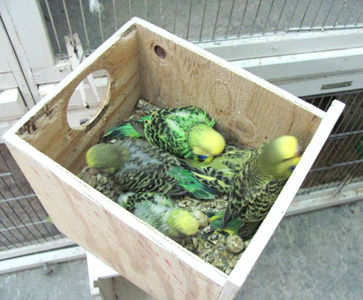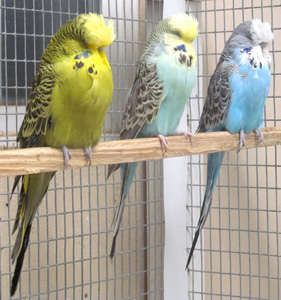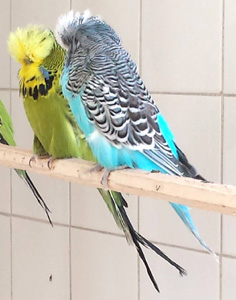“We’ve let the breeding season stretch across too
much of the year”.. Eric Peake believes.

After the success of the 2007 BS Club Show the fancy
can surely look forward to the new breeding season.
Birds in the past have all been geared to the show
calendar, to be bred to coincide with the January 1st ring-issue
date. But have we really looked at the behavior pattern attributed to the
delightful bird we keep? I think not.
Most breeders pair up in November to ring their
babies with the forthcoming year’s coded rings. Is that wise? Yes, most will
say. But if a record were made across the UK of successful fertility in the
first round, you would find a large percentage of loss in fertility and an
increase in chick mortality in the first round.

Why? The budgerigar is a southern hemisphere bird
that breeds in the bush during the rainy season, under intense heat during
the day and cool nights. Yet in captivity we try to breed just for the ring
issue date, forgetting that night – and day – temperatures can drop rapidly.
The birds must maintain heat to incubate the eggs and keep the babies alive.
No matter what heat you can provide, the November to March climate is not
satisfactory for this southern-bred bird.
The “annual moult” is sometimes mentioned, but there
is no such thing. All of a budgerigar’s feathers will be replaced throughout
the calendar year. Only the main flight and tail feathers will fall out at a
set time of the year – usually October to December. These new feathers will
be essential to strengthen the bird’s flight in the breeding season, to
equipe it to fly long distances to find food for its family.
Research has shown that birds bred at about the same
time will also moult at about the same time. To balance the bird in flight,
the feathers in the primary group will fall out equally left to right,
whereas the main tail feathers will fall out consecutively. With their
larger feathers, modern birds can struggle in flight when they are trying to
manoeuvre in a tight space. We should watch the feather size and quality,
otherwise nature will take its course and eradicate all birds that are seen
to deviate from the norm.
Common sense in breeding feather qualities is a must.
We still have fanciers who look at feather only, and forget that progress
with the species is more important. Recent years have seen a huge rise in
cysts, feather lumps, feather deformities and feather diseases all created
by people, not nature.
Experience has taught me to breed in the Spring-time
in the UK. Our budgerigars still maintain the pattern of behavior of the
wild cousins in Australia. I’ve always bred from March onwards, to give the
breeding birds rest periods in the Winter. This lets them replace their
feathers, get into next year’s breeding condition and – since they don’t
have to rear babies – incubate eggs during our cold, damp seasons.

Breeding in better weather ... results in better production..
When they are breeding the weather is better, and
during June and July the hens can safely stay off their eggs or babies
without the risk of chill. Last year, for the first time, I paired up in
April, a bit nearer the ideal weather conditions – and my breeding season
was an outstanding success. My young birds were not ready for the early
shows, but I don’t want to risk my birds simply to get an accolade. My
reward was a good breeding season without the problems that come with early
breeding. The birds have a five-month rest-period from November to March. So
I didn’t have any worry about chilled eggs, dark evenings, or cold
conditions.
During my study of the budgerigar, at Keele
University in the 1960s, I found that UK fanciers bred mainly for time-slots
dictated by ring issues, rather than what the birds really wanted. Some
birds will continually breed without a rest-period, others will not. Some
birds will be wonderful parents, others won’t. Birds differ in their pattern
of behavior, yet we dictate when they breed, forgetting that it may go
against their instinct to complete a family.


So most birds in the UK breed during November to
June. Look at the number of chick fatalities, clear eggs and so on, and you
will find that April to June produces the fewest problems.
One of the biggest difficulties occurs if a fancier
buys a hen in November or December. If that hen was hatched in May or June,
it’s still only five months old. Many birds bought at shows, where there is
no record of their date of birth, fall into this category.
It is always safe practice to breed from a one-year
old hen or cock. While cocks are sometimes ready to breed at 10 months, I
pair up after a bird is a year old. The pairs I favor are an old cock to a
young hen, or a young cock to an old hen, This seems to work better than two
birds in their first year of breeding.
Why Spring is the best time to find your partners?:
![]() Days and nights are warmer.
Days and nights are warmer.
![]() Wild birds in the UK always breed in Spring.
Wild birds in the UK always breed in Spring.
![]() The days are longer, allowing you to attend to the
stock.
The days are longer, allowing you to attend to the
stock.
![]() Hens are happier in warm conditions.
Hens are happier in warm conditions.
![]() Non-breeding birds can rest at the worst time of the
year in weather pattern
Non-breeding birds can rest at the worst time of the
year in weather pattern
![]()
![]()
![]() It works for me!
It works for me!
![]() Check
out more articles in our Reference
Library
Check
out more articles in our Reference
Library
